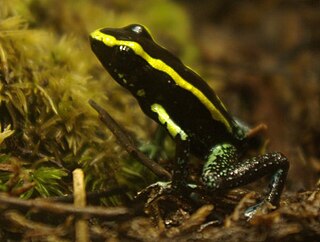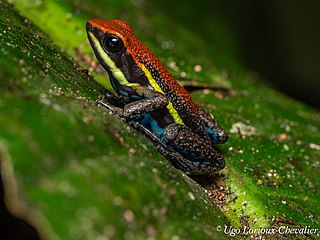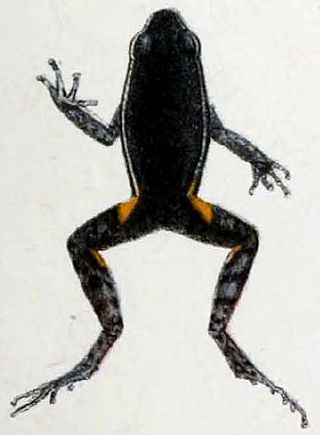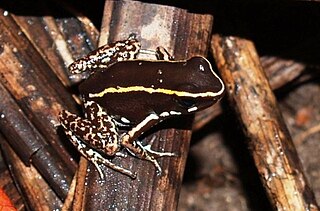
The phantasmal poison frog or phantasmal poison-arrow frog is a species of poison dart frog. It is endemic to Ecuador and known from the Andean slopes of central Ecuador in Bolívar Province. They have radiant colors. This species is endangered, and there are only a few locations in the wild where they are known to live.

The yellow-banded poison dart frog, also known as yellow-headed poison dart frog or bumblebee poison frog, is a poison dart frog from the genus Dendrobates of the family Dendrobatidae.
The sky-blue poison frog is a species of poison dart frog. It is endemic to Peru and known from the lower eastern versant of the Andes in the upper Amazon basin of the San Martín Region.

Phyllobates aurotaenia is a member of the frog family Dendrobatidae, which are found in the tropical environments of Central and South America. First described by zoologist George Albert Boulenger in 1913, P. aurotaenia is known for being the third most poisonous frog in the world. It is the smallest of the poison dart frogs in the Phyllobates genus and is endemic to the Pacific coast of Colombia.
Hyloxalus infraguttatus, also known as the Chimbo rocket frog, is a species of frog in the family Dendrobatidae. It is found on the Pacific slopes of the Andes in Ecuador, and, based on the Amphibian Species of the World and the Checklist of Colombian Amphibians, also in Nariño, southern Colombia. Based on the proximity of the southern limit of its known distribution to the Peruvian border, it is likely that it occurs in northern Peru too.
Epipedobates machalilla is a slender species of frog in the family Dendrobatidae. Endemic to West Ecuador, it lives in dry and low forests and was first described by Luis A. Coloma in 1995. The IUCN have classed it as "least concern".

Hyloxalus nexipus is a species of frog in the family Dendrobatidae. It is found on eastern slopes and foothills of the Andes from southeastern Ecuador south to the region of Yurimaguas in Peru.

Allobates ornatus is a species of frog in the family Aromobatidae. It is endemic to northern Peru where it is only known from near its type locality, Tarapoto in the San Martín Province, on the eastern slopes of the Cordillera Oriental.
Hyloxalus toachi is a species of frog in the family Dendrobatidae. It is endemic to northwestern Ecuador.
The yellow-bellied poison frog, yellow-bellied poison-arrow frog, or yellowbelly poison frog is a species of frog in the family Dendrobatidae. It is found in northwestern Colombia and east-central Panama.

The blue-bellied poison frog or bluebelly poison frog is a species of frog in the family Dendrobatidae.
The marbled poison frog or marbled poison-arrow frog is a species of frog in the family Dendrobatidae found in western Colombia and northwestern Ecuador, at elevations of 10–1,500 m (33–4,921 ft) asl. It likely represents a species complex of at least two species.
Ameerega braccata, formerly Epipedobates braccatus, is a species of frog in the family Dendrobatidae. It is endemic to the Central-West Region of Brazil and is known from southern Mato Grosso, Mato Grosso do Sul, and southwestern Goiás states; however, it is likely that its true range extends into adjacent Bolivia and Paraguay.

The Cainarachi poison frog is a species of frogs in the family Dendrobatidae. It is endemic to Amazonian Peru and found in the lowlands adjacent to the northern end of the Eastern Andes. It was named after the Rio Cainarache Valley, where it was first discovered.

Ameerega hahneli is a species of frog in the family Dendrobatidae. It is found in the Amazonian lowlands of Brazil, Bolivia, Peru, Ecuador, Colombia, Venezuela, Guyana, French Guiana, and Suriname. It is named after Paul Hahnel, the collector of the type series.
Silverstone's poison frog is a species of frog in the family Dendrobatidae endemic to Peru. Its natural habitats are subtropical or tropical moist lowland forests and rivers.

Ameerega trivittata, formerly Epipedobates trivittatus, is a species of frog in the family Dendrobatidae commonly known as the three-striped poison frog. It is found in Bolivia, Brazil, Colombia, Guyana, Peru, Suriname, Venezuela, possibly Ecuador, and possibly French Guiana.

The lovely poison frog or lovely poison-arrow frog is a species of frog in the family Dendrobatidae. It is found on the Caribbean versant of Central America from southeastern Nicaragua through Costa Rica to northwestern Panama, with one record just west of the Panama Canal. Populations from the Pacific versant, formerly included in this species, are now identified as Phyllobates vittatus.

Ranitomeya sirensis or the Sira poison frog is a species of poison dart frog found in the Amazonian rainforests of northern Bolivia, westernmost Brazil (Acre), and eastern Peru.
Excidobates captivus, the Santiago poison frog or Rio Santiago poison frog, is a species of frog in the family Dendrobatidae. It is endemic to northwestern Peru and southern Ecuador. Its natural habitat is tropical moist lowland forests. This frog is black with rows of orange-red spots on its back and yellow spots underneath.












